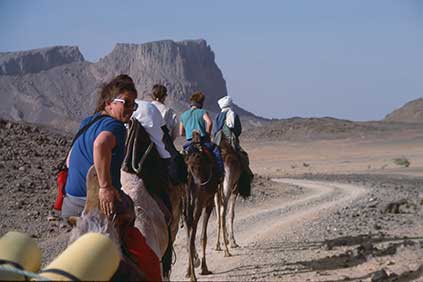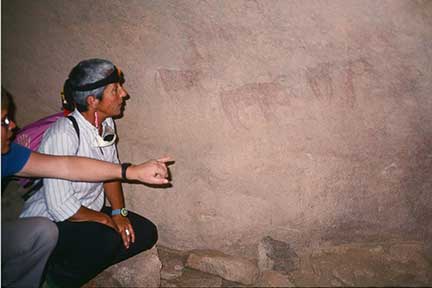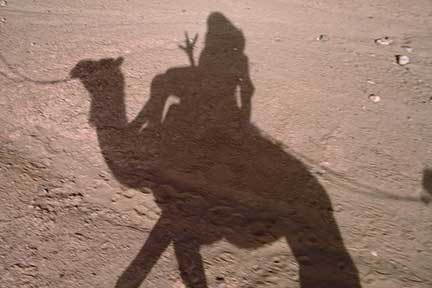 Overnight Camel Trek
Overnight Camel Trek
December 8 - 9, 1987
After the Hogar Mountain trip, we went on an overnight camel trek. Some of the group went out on camels just for an afternon but didn't enjoy it much. Camels have an unusual gait—you're thrown backward and forward with each step. I used to think think horse saddles were uncomfortable! Camel saddles are the worst, at least the kind they use in Algeria! There's a piece of flat wood under you, a piece of flat wood behind you, and a pommel in front. You ride with your bare feet on the camel's neck.
It took a long time to figure out how to ride with some degree of comfort. The forward pitch of the camel gait throws you right onto the pommel. Going downhill you have to hang on to the hump behind the saddle for dear life—it's really rough! I managed to sort of wedge myself into the saddle. It took a bit of skin off my back but otherwise was fine. What amazed us was the grace of our Touareg guide in his saddle. Toward the end of our ride back, I finally figured out how to ride like him (more or less) by moving myself to match the movement of the camel.
I was quite ready to stop after one and a half hours of winding through the desert. No sand dunes, just bare ground and rock with a dry stream bed here and there. Very pretty. It reminded me in some ways of the Grand Canyon without vegetation.
We camped in a sandy stream bed and it was nice being in a smaller group—just seven of us and the guide, who spoke no English. I used my French and found out he owns 34 camels, so he is a relatively rich man. He also had a beard, which for Muslims is an indication that they've done the hajj, the pilgrimage to Mecca. That's another indication of relative wealth. He wasn't rich by our standards, but one thing I like about Africa is the simplicity of life. The Tuareg love their nomadic life and the desert. I liked the ones we met. They had a good sense of humor and were hospitable and down-to-earth.
The guide hobbled the camels and turned them loose to graze. We gathered firewood and he pointed the way to a nearby guelta (water hole).
 Dennis went with the guide and another traveler to the guelta, which was about a half mile away. The guide came back with water, but no Dennis. I waited quite awhile, then decided to look for him. I found him and the other traveler with a French teacher they'd met. She had shown them prehistoric cave paintings she'd discovered!
Dennis went with the guide and another traveler to the guelta, which was about a half mile away. The guide came back with water, but no Dennis. I waited quite awhile, then decided to look for him. I found him and the other traveler with a French teacher they'd met. She had shown them prehistoric cave paintings she'd discovered!
As we returned to see the paintings, we ran across three young Tuareg men having tea over a small open fire. They said they came out to the desert often to get away from the city. Tamanrasset is hardly what Americans would call a "city"!
They invited us to tea. They made it in a teeny-tiny teapot by pouring boiling water over mint leaves again and again. It was served in teeny-tiny glasses chock full of sugar.
(They are crazy about sugar. Our guide consumed all the sugar we had brought. We were lucky to get more when the young men passed us on their way home.)
Jeane, the Frenchwoman, took us to the paintings, of a buffalo or bull and a giraffe. The paintings were in a secluded and sheltered place. I don't know how she managed to find them. It's amazing to think that animals like those pictured lived here thousands of years ago.
 The next morning we helped the guide round up the camels. They had ranged pretty far, but they didn't run or try to get away, despite the fact that as they were loaded, they screamed and protested. One camel we loaded so heavily that I was reminded of "the straw that broke the camel's back." Camels can carry up to 400 pounds, but they don't like it. There is no bridle, just a slip knot in a rope around the camel's lower lip. I have no idea how the riders steer them. Our group was roped to the guide and followed along. He did all the steering.
The next morning we helped the guide round up the camels. They had ranged pretty far, but they didn't run or try to get away, despite the fact that as they were loaded, they screamed and protested. One camel we loaded so heavily that I was reminded of "the straw that broke the camel's back." Camels can carry up to 400 pounds, but they don't like it. There is no bridle, just a slip knot in a rope around the camel's lower lip. I have no idea how the riders steer them. Our group was roped to the guide and followed along. He did all the steering.
Go on to South to Niger across the Sahara
Source: www.SusanCAnthony.com, ©Susan C. Anthony
